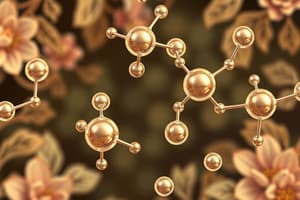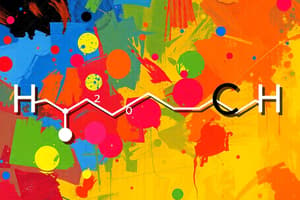Podcast
Questions and Answers
What is the primary function of lithium aluminium hydride (LiAlH4) in organic transformations?
What is the primary function of lithium aluminium hydride (LiAlH4) in organic transformations?
- To hydrolyze amides into carboxylic acids
- To perform electrophilic aromatic substitution
- To oxidize alcohols to aldehydes
- To reduce carbonyl groups to alcohols (correct)
In the reduction of β-aryl-α,β unsaturated carbonyl compounds, what is a key outcome when using LiAlH4?
In the reduction of β-aryl-α,β unsaturated carbonyl compounds, what is a key outcome when using LiAlH4?
- Only the alkene functional group is reduced
- Only the carbonyl functional group is reduced
- The carbon-carbon double bond remains intact
- Both the carbon-carbon double bond and the carbonyl group are reduced (correct)
Which type of compound is formed when propargylic alcohols (R–C≡C–CH2OH) are reduced using lithium aluminium hydride?
Which type of compound is formed when propargylic alcohols (R–C≡C–CH2OH) are reduced using lithium aluminium hydride?
- Dienes
- Saturated alcohols
- Trans alkenes (correct)
- Aldehydes
How does the mechanism of reduction using lithium aluminium hydride primarily occur?
How does the mechanism of reduction using lithium aluminium hydride primarily occur?
Which of the following is NOT a common application of lithium aluminium hydride in organic chemistry?
Which of the following is NOT a common application of lithium aluminium hydride in organic chemistry?
What is the primary effect of adding AlCl3 to LiAlH4 in a mixed lithium aluminium hydride-aluminium chloride reagent?
What is the primary effect of adding AlCl3 to LiAlH4 in a mixed lithium aluminium hydride-aluminium chloride reagent?
Which reaction product is formed when LiAlH4 reacts with 3AlCl3?
Which reaction product is formed when LiAlH4 reacts with 3AlCl3?
What can be inferred about the reducing ability of mixed lithium aluminium hydride-aluminium chloride compared to LiAlH4 alone?
What can be inferred about the reducing ability of mixed lithium aluminium hydride-aluminium chloride compared to LiAlH4 alone?
In the context of nucleophilic attack, how does LiAlH4 primarily function?
In the context of nucleophilic attack, how does LiAlH4 primarily function?
Which functional group is readily reduced by lithium aluminium hydride?
Which functional group is readily reduced by lithium aluminium hydride?
Flashcards are hidden until you start studying
Study Notes
Carboxylic Amides Reduction
- Carboxylic amides can be converted into amines or aldehydes through reduction.
- Lithium aluminium hydride (LiAlH4) is commonly used as the reducing agent, often in tetrahydrofuran (THF) at low temperatures.
Alkene and Carbonyl Compound Reduction
- Reducing β-aryl-α,β unsaturated carbonyl compounds using LiAlH4 results in the reduction of both the carbonyl group and carbon-carbon double bond.
- Various conditions like temperature adjustments (e.g., -10ºC or 35ºC) can influence the reduction process, with alternative reagents like sodium borohydride (NaBH4) or DIBAL-H also applicable.
Propargylic Alcohol Reduction
- Propargylic alcohols are reduced with LiAlH4 to yield trans alkenes.
- A mixed lithium aluminium hydride-aluminium chloride reagent can form, altering the reducing power of LiAlH4.
Mixed Hydride Reagent Reactions
- Formations like LiAlH3 and other mixed hydrides occur with AlCl3, affecting the reactivity of reducing agents.
- For example, the addition of AlCl3 can decrease LiAlH4's ability to reduce functional groups compared to its standalone use.
Lithium Tri-t-butoxyaluminium Hydride
- Lithium tri-t-butoxyaluminium hydride ([LiAlH(OtBu)3]) is a milder reducing agent than LiAlH4.
- This reagent can reduce various functional groups, with specific outcomes:
- Aldehydes and ketones reduce to alcohols.
- Carboxylic esters, epoxides react slowly.
- Halides, nitriles, and nitro groups typically are not reduced.
Preparation of Lithium Tri-t-butoxyaluminium Hydride
- [LiAlH(OtBu)3] is synthesized by reacting lithium aluminium hydride with tert-butyl alcohol, employing a stoichiometric relationship.
Studying That Suits You
Use AI to generate personalized quizzes and flashcards to suit your learning preferences.




